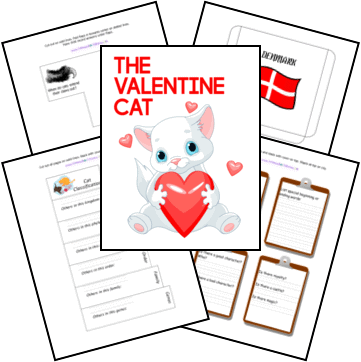Affiliate Disclaimer
We sometimes use affiliate links in our content. This won’t cost you anything, but it helps us to keep the site running. Thanks for your support.
The fortunes of a little black cat–with a heart-shaped spot on his forehead–lost in the woods, befriended by a poor artist, stolen by a mean chimney sweep, and finally reunited with his friend.
This story is the springboard for lessons on cats, pet care, the Middle Ages, and, of course, Valentine’s Day. Grab our The Valentine Cat unit study and lapbook to get started.
Thanks to Wende for writing the lessons and preparing the printables for this The Valentine Cat unit study and lapbook.
The Valentine Cat Unit Study Lessons
This unit study includes lessons and printables based on the book The Valentine Cat by Clyde Robert Bulla.
Here are some sample lessons from the The Valentine Cat Unit Study.
Science: Stray Animals
The Valentine Cat was a stray. Stray animals are those that do not have homes. People should be very cautious around stray animals. You can’t tell for sure if the animal is just temporarily lost, or if it has always been wild. Stray animals are usually hungry and scared, which can make them dangerous. They may carry diseases. Warn your children not to approach a stray animal. You may want to visit an animal shelter while sharing this book to see how some strays are taken care of and relocated to homes.
History: Medieval Occupations
Various occupations are featured throughout The Valentine Cat.
Discuss the following:
Woodcutter – The woodcutter was a medieval profession that involved high risk and loneliness. He would live in the forest and live in temporary dwellings depending on where he was cutting down wood. His lord or overseer would give him other work to do depending on what needed done. Sometimes the woodcutter might have to build a bridge or other project, weed out and make clearings, collect and bundle wood, collect bark for the tanners, help in the sawmill or charcoaling wood for the castle. He was strong and brave and often thought of as being suspicious by the villagers. His job was dangerous. He could be hurt from falling trees, his tools, thieves, or wild animals in the forest. Just like any other job in the medieval city there were stages of wealth and success in the particular job. Not all woodcutters were peasants. Their wealth depended on the success of their crops. Some were woodcutters for the hierarchy, while some were independent woodcutters.
Farmer –The farmer took his straw to market in a horse drawn cart. Where does straw come from?
Straw comes from small grain like wheat or barley. Once the grain has been threshed the by-product is straw which is used for bedding for animals.
Shoemaker – Tell was a shoemaker. A shoemaker is one who makes and repairs shoes. There were more shoemakers in a medieval city than any other job.
Palace Guard – They were the king’s personal military to protect his home.
Chimney Sweeps – Ketch was a chimney sweep, a peasant job. The job of the chimney sweep was to clean all the soot out from inside chimneys. The castle had many chimneys that needed cleaning. Chimneys are as old as time so this occupation is one of the oldest in the world. Still considered “good luck” for a bride to seen by a chimney sweep on her wedding day or be blown a kiss any day!
King – The king is the ruler of a kingdom and the owner of all the land.
Queen – The king’s wife, who shared in the ruling as well as running her household.
Princess – The daughter of the king and queen.
Maid – a female household servant. A maid is always female;
Entertainers – The royalty and nobles would often hire entertainment. This entertainment could include dancers, jesters, or musicians such as the drummers, fiddlers, and horn players that marched in the parade.
You can grab a copy of the entire The Valentine Cat Unit Study and Lapbook in an easy-to-print file at the end of this post.
The Valentine Cat Lapbook Printables
In addition to a myriad of unit study lessons, this file contains a variety of mini-books for your student to make a The Valentine Cat Lapbook.
- Vocabulary Flap Book
- Cat Math Mini-book
- My Antonym Book
- Prepositions Strip Book
- Fairy Tale Detective Clipboards
- My Castle Story Shutterfold
- Castle Copywork Simple Fold
- February Calendar & Pocket
- Types of Sentences Cards & Pocket
- The Queen of Hearts Copywork
- Shapes Simple Fold
- Compound Word Cards & Pocket
- Denmark Map Shutterfold
- Medieval Jobs Mini-book
- Medieval Punishments T-book
- Denmark Notebook Page & Pocket
- Pets Tab Book
- And more!
How to Get Started with Your Free The Valentine Cat Unit Study & Lapbook
Follow these simple instructions to get started with the The Valentine Cat Unit Study:
- Buy a copy of the book, The Valentine Cat, or borrow one from your local library.
- Print the The Valentine Cat unit study.
- Choose the lessons you want to use with your student (a highlighter works great for this).
- Choose and prepare the lapbook printables you want to use with your student.
- Enjoy a week of learning about pets, the Middle Ages, and Valentine’s Day.
Get Your Free The Valentine’s Day Cat Unit Study & Lapbook
Simply click on the image below to access your free The Valentine Cat Unit Study and Lapbook.










